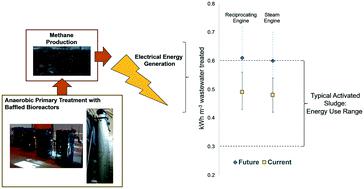当前位置:
X-MOL 学术
›
Environ. Sci.: Water Res. Technol.
›
论文详情
Our official English website, www.x-mol.net, welcomes your
feedback! (Note: you will need to create a separate account there.)
Energy-generating potential of anaerobically enhanced primary treatment of domestic wastewater using multiple-compartment bioreactors
Environmental Science: Water Research & Technology ( IF 3.5 ) Pub Date : 2019-11-05 , DOI: 10.1039/c9ew00526a Andrew Pfluger 1, 2, 3, 4, 5 , Rebecca Erickson 1, 2, 3, 4, 5 , Gary Vanzin 1, 2, 3, 4, 5 , Martha Hahn 1, 2, 3, 4, 5 , Jennie Callahan 1, 2, 3, 4, 5 , Junko Munakata-Marr 1, 2, 3, 4, 5 , Linda Figueroa 1, 2, 3, 4, 5
Environmental Science: Water Research & Technology ( IF 3.5 ) Pub Date : 2019-11-05 , DOI: 10.1039/c9ew00526a Andrew Pfluger 1, 2, 3, 4, 5 , Rebecca Erickson 1, 2, 3, 4, 5 , Gary Vanzin 1, 2, 3, 4, 5 , Martha Hahn 1, 2, 3, 4, 5 , Jennie Callahan 1, 2, 3, 4, 5 , Junko Munakata-Marr 1, 2, 3, 4, 5 , Linda Figueroa 1, 2, 3, 4, 5
Affiliation

|
Wastewater reclamation facilities have the potential to be net energy producers if anaerobic bioreactors coupled with energy-generating technologies, such as combined heat and power (CHP), are employed. To characterize the energy-generating potential of multiple-compartment anaerobic bioreactors used for enhanced primary treatment of domestic wastewater, organic removal and observed methane (CH4) generation from two pilot-scale anaerobic baffled bioreactors operating for more than 2400 days over a range of wastewater temperatures (11 to 24 °C) were characterized. Aggregated data from both bioreactor systems were subjected to uncertainty analysis and modeling to increase confidence in results and to determine the energy-generating potential from five different CHP technologies. Results suggest that multiple-compartment anaerobic reactors converted 76% of the chemical oxygen demand (COD) removed to methane-rich biogas (effective energy content of 2.0 kW h kg−1 COD removed). Observed CH4 production was most accurately modeled using total COD measurements, not biodegradable COD estimates. The use of the aerobic biochemical oxygen demand (BOD) assay underestimated the amount of anaerobically biodegradable COD. Modeled scenarios suggest that energy generated from several CHP technologies with heat recovery (i.e., effective electrical energy) can provide power equivalent to the amount used by many conventional activated sludge systems. A modeled future scenario where dissolved methane (dCH4) is recovered for energy generation also suggests that dCH4 capture provides additional energy generation and is needed to reduce greenhouse gas emissions. Based on COD, mass balances indicate that using multiple-compartment anaerobic reactors for anaerobically enhanced primary treatment increases the portion of COD in the influent wastewater going to electrical energy from ∼8.5% to 21%. Results from this study suggest that replacing conventional primary treatment with anaerobic bioreactors can enhance energy-generating potential at water resource recovery facilities.
中文翻译:

使用多隔室生物反应器厌氧强化生活污水的初级处理的发电潜力
如果采用厌氧生物反应器与诸如热电联产(CHP)等能源产生技术相结合,则废水回收设施有可能成为净能源生产者。表征多室厌氧生物反应器的发电潜力,该反应器用于增强生活污水的一级处理,去除有机物和观察到的甲烷(CH 4表征了在一定范围的废水温度(11至24°C)下运行超过2400天的两个中试厌氧折流式生物反应器的产生情况。来自两个生物反应器系统的汇总数据都经过不确定性分析和建模,以提高结果的可信度,并确定五种不同的热电联产技术的发电潜力。结果表明,多室厌氧反应器将去除的76%的化学需氧量(COD)转化为富含甲烷的沼气(去除了2.0 kW h kg -1的COD的有效能量)。观测到的CH 4使用总的COD测量值而非可生物降解的COD估算值可以最准确地模拟生产。有氧生化需氧量(BOD)测定法的使用低估了需氧生物可降解COD的量。建模的场景表明,几种具有热回收的热电联产技术产生的能量(即有效电能)可以提供与许多常规活性污泥系统所使用的能量相等的功率。在模型化的未来情景中,将溶解的甲烷(dCH 4)回收用于发电,这也表明dCH 4捕集能提供更多的能源,是减少温室气体排放所必需的。基于化学需氧量,质量平衡表明,使用多室厌氧反应器进行厌氧强化的一级处理,可将流入废水的电能中的化学需氧量比例从约8.5%增加到21%。这项研究的结果表明,用厌氧生物反应器代替常规的一级处理可以提高水资源回收设施的发电潜力。
更新日期:2019-11-05
中文翻译:

使用多隔室生物反应器厌氧强化生活污水的初级处理的发电潜力
如果采用厌氧生物反应器与诸如热电联产(CHP)等能源产生技术相结合,则废水回收设施有可能成为净能源生产者。表征多室厌氧生物反应器的发电潜力,该反应器用于增强生活污水的一级处理,去除有机物和观察到的甲烷(CH 4表征了在一定范围的废水温度(11至24°C)下运行超过2400天的两个中试厌氧折流式生物反应器的产生情况。来自两个生物反应器系统的汇总数据都经过不确定性分析和建模,以提高结果的可信度,并确定五种不同的热电联产技术的发电潜力。结果表明,多室厌氧反应器将去除的76%的化学需氧量(COD)转化为富含甲烷的沼气(去除了2.0 kW h kg -1的COD的有效能量)。观测到的CH 4使用总的COD测量值而非可生物降解的COD估算值可以最准确地模拟生产。有氧生化需氧量(BOD)测定法的使用低估了需氧生物可降解COD的量。建模的场景表明,几种具有热回收的热电联产技术产生的能量(即有效电能)可以提供与许多常规活性污泥系统所使用的能量相等的功率。在模型化的未来情景中,将溶解的甲烷(dCH 4)回收用于发电,这也表明dCH 4捕集能提供更多的能源,是减少温室气体排放所必需的。基于化学需氧量,质量平衡表明,使用多室厌氧反应器进行厌氧强化的一级处理,可将流入废水的电能中的化学需氧量比例从约8.5%增加到21%。这项研究的结果表明,用厌氧生物反应器代替常规的一级处理可以提高水资源回收设施的发电潜力。











































 京公网安备 11010802027423号
京公网安备 11010802027423号